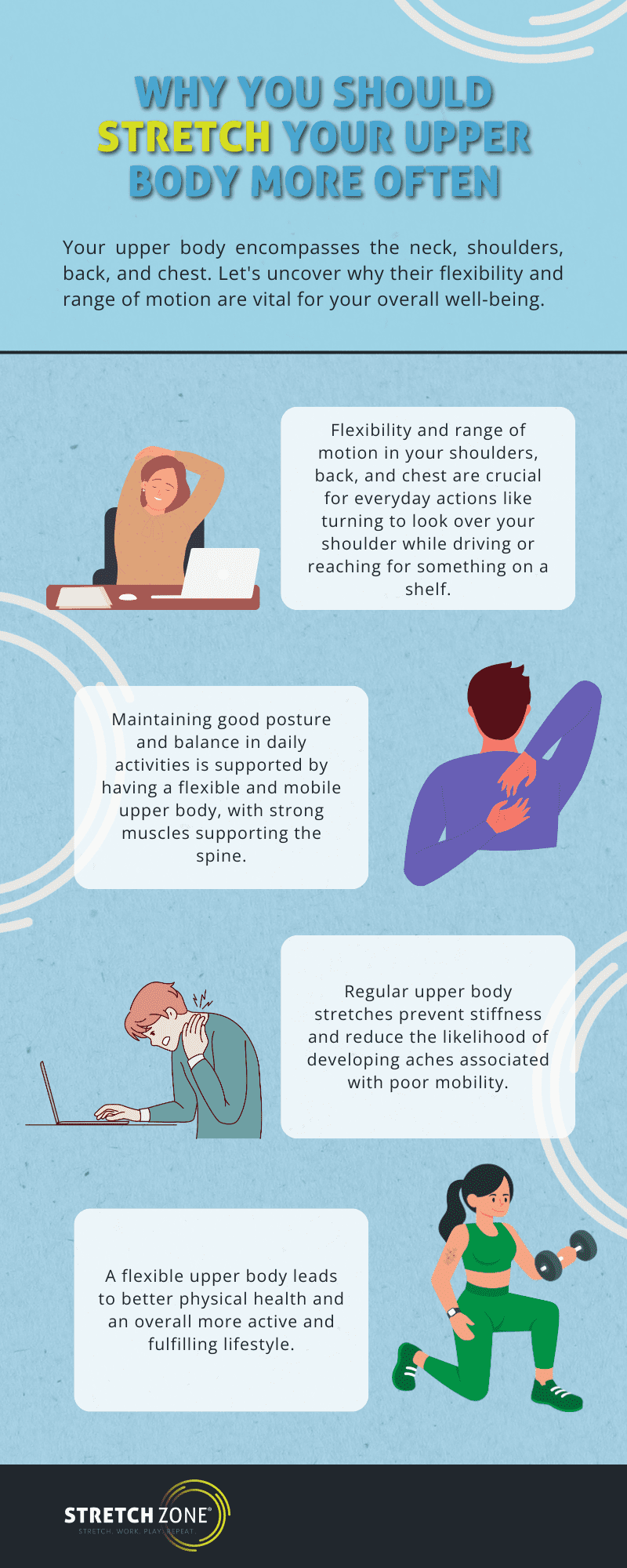In our busy lives, we often overlook the strength tucked away in our upper body. While we might take care of various aspects of our health, the shoulders, back, neck and chest quietly carry their weight and deserve some attention too.
Consider reaching for something high or turning to fasten your seatbelt, maybe bending and lifting your kids or grandkids — these actions all rely on your upper body. The beauty is, with upper body stretches such as back, arms, and chest stretches, we can care for those areas and enhance how we move. This means enjoying and being able to do these activities more freely. So, let’s dig deeper into why starting to stretch your upper body today can make a real difference.
Getting to Know Your Upper Body
Your upper body encompasses the neck, shoulders, back, and chest, each playing a distinctive role in supporting and facilitating a variety of movements essential to daily life.
- Neck: The neck serves as a crucial connector between the head and the torso. The cervical spine and surrounding muscles allow for essential movements like turning, tilting, and nodding, contributing to the overall flexibility and functionality of the upper body.
- Shoulders: Your shoulders are the versatile leaders of the upper body. The deltoids shape your shoulders, while the rotator cuff muscles allow for everyday movements like lifting, swinging, and reaching.
- Back: Moving to the back, it acts as the support system for your body. The spine is the backbone, and muscles like the latissimus dorsi and trapezius play essential roles in maintaining posture, enabling you to stand tall, twist, and bend.
- Chest: Lastly, the chest houses the pectoral muscles, central to actions like hugging, pushing, and pulling. These muscles are pivotal in various upper body movements, making everyday activities smoother.
Why You Should Work on a Flexible Upper Body

Now that we’ve met the key players in your upper body, let’s uncover why their flexibility and range of motion are vital for your overall well-being.
Facilitating Everyday Movements
Your upper body is the linchpin for everyday actions. From turning to look over your shoulder while driving to reaching up for something on a shelf, these seemingly simple tasks rely heavily on the flexibility and range of motion of your shoulders, back, and chest.
Enhancing Posture and Balance
A flexible and mobile upper body contributes significantly to maintaining good posture. The muscles supporting your spine play a crucial role in standing tall and moving gracefully, promoting better balance in your daily activities.
Preventing Aches
Stiffness in the upper body can lead to discomfort and even aches. By keeping these muscles supple through regular stretches, you not only prevent stiffness but also reduce the likelihood of developing aches associated with poor upper body mobility.
Supporting Overall Physical Health
Flexibility in your upper body is not just about reaching or bending; it’s about fostering a healthy, resilient body. A well-maintained upper body enhances your overall physical health, contributing to a more active and fulfilling lifestyle.
Habits That Can Adversely Affect Your Upper Body
Certain habits may unknowingly contribute to lack of flexibility, discomfort and strain in the chest, shoulders, back, and neck. Identifying and addressing these habits can significantly impact the health of your upper body. Let’s explore common practices that may be hurting these specific areas.
Prolonged Sitting
Extended periods of sitting, prevalent in desk jobs or sedentary lifestyles, can lead to poor posture, causing strain in the chest, shoulders, and back. Implementing breaks and incorporating stretches throughout the day can mitigate these effects.
Incorrect Screen Height
Improperly positioned computer screens can contribute to neck and shoulder discomfort. Ensuring that screens are at eye level helps maintain a neutral neck position, reducing the risk of strain.
Heavy Backpacks or Bags
Carrying heavy backpacks or shoulder bags can strain the shoulders and back. Distributing weight evenly, using backpacks with padded straps, and opting for crossbody bags can alleviate this burden.
Poor Sleeping Positions
Sleeping in positions that strain the neck or back can contribute to discomfort. Utilizing supportive pillows and maintaining proper sleep posture can promote spinal alignment and reduce strain.
Overlooking Ergonomics
Neglecting ergonomic considerations in work or home environments can lead to poor posture and discomfort. Adjusting furniture and equipment to support a natural body position helps prevent strain in the upper body.
Excessive Phone Use
Constantly looking down at phones can strain the neck and contribute to “text neck.” Holding phones at eye level or taking breaks from prolonged use can alleviate this strain.
Lack of Physical Activity
A sedentary lifestyle can weaken the muscles in the chest, shoulders, and back. Incorporating regular physical activity, including targeted upper body exercises, helps maintain muscle strength and flexibility.
Read full article at Stretch Zone’s Blog











